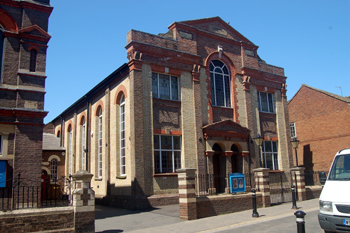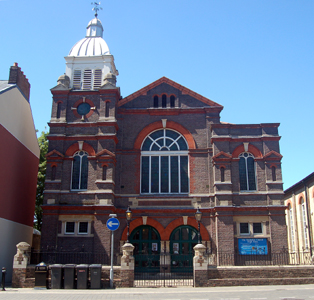
The High Town Methodist Chapel of 1854 - June 2010
The history of Primitive Methodism in HighTown from 1838 to 1932 is given in a booklet called The Hill of the Lord being the Story of Hightown Primitive Methodist Church 1838-1932 by Robert K. Spedding [MB709]. In 1839 two men named Higginson and Turner became the first Primitive Methodists to Luton, coming from Aylesbury [Buckinghamshire] to preach in the neighbourhood. They also preached in Houghton Regis and Dunstable.
A week after Higginson and Turner first preached in Luton they were invited back by the town and preached in the Market Hall. They must have had an enormous impact because a church holding over 350 and costing over £300 opened on 14th November that near the later stationmaster’s house in Midland Road in the locality then called Donkey Hall. The first Primitive Methodist Luton Circuit was formed in 1843, Luton having previously been part of the Aylesbury Circuit. A chapel was registered in High Town on 2nd April 1845 but was substituted on 15th December 1866.
On Sunday 30th March 1851 a national religious census was undertaken. Each place of worship was asked to give attendance figures for each service held that day. Bedfordshire returns were compiled by D. W. Bushby and published in Bedfordshire Historical Record Society Volume 54 in 1975. HighTown Primitive Methodist was recorded as having 130 free sittings, 220 other seats and room for 50 people standing. 500 people and 178 Sunday scholars attended in the morning and a stupendous 900 people and 178 Sunday scholars at both the afternoon and evening services. The averages for the preceding twelve months were 200, 350 and 400 general congregations at each service respectively; with Sunday scholars at each serve averaging 178, 178 and 128 respectively. The minister, Harry Pope, remarked: “Our Religious Services were held in the Town Hall, our Chapel being too small for our congregation”. The Town Hall was registered for worship in November 1848 by Richard Vyse, John Jones, Robert How and Edmund Williamson, all of Luton [ABN1/2; ABN2/401].
![The Town Hall before 1919 [Z50/75/72]](/CommunityHistories/Luton/LutonImages/The Town Hall - the Belgium Arms left immediately .jpg)
The Town Hall before 1919 [Z50/75/72]
This first chapel was sold to the Midland Railway Company in 1852 as part of the site for their new railway from Leicester to Hitchin which ran through Luton and opened in 1857. A new chapel, seating 800, was completed in High Town Road in 1854 to accommodate the large numbers wishing to worship. A large schoolroom was added in 1861. This building still stands and was listed by the former Department of Environment in February 1981 as Grade II, of special interest. The listing describes the building as “simplified classical style with some Italianate touches” stating that it is “unusual for the use of brick architectural polychromy on the front”.
A second Luton Primitive Methodist Circuit, called ParkTown, was formed 1879 the original one being renamed HighTown. A new chapel was built next door to the 1854 chapel in 1897 the old one becoming the Sunday School. A map of 1880 [MC1/4/L2] shows that this new chapel was built on the site of a cottage hospital. This new chapel was also listed as Grade II in February 1981. This building is described as: “simple neo-classical style with Byzantine overtones, and large Baroque cupola topping the left hand bay”. It is constructed of Luton grey bricks with red brick and stone dressings and a Welsh slate roof with crested ridge tiles.

The High Town Primitive Methodist Chapel of 1897 - June 2010
In 1932 the Primitive Methodists and two other branches of Methodism, the Wesleyan Methodists and United Methodists came together to form the Methodist Church of Great Britain. Luton Methodist High Town Circuit was formed the following year from former Primitive Methodist chapels which did not with to join the new Luton Circuit. The High Town Circuit included churches in HighTown itself as well as Cardigan Street, Sharpenhoe, Barton-le-Clay and Leagrave (Marsh Road).
In his invaluable 200 pamphlet Luton Methodism in the 20th Century, Circuit Archivist Irving Rumbles [MB2876] noted that the 1938 Methodist Recorder stated: “Luton is probably the most prosperous town in England” and it was predominantly Methodist. The Luton Methodist Circuit was created in 1944 when the High Town Circuit was finally subsumed into a greater whole. It did not last long as Luton split into North and South Circuits in 1965. The High Town Road Methodist church remains an active place of worship at the time of writing [2011].
The Hill of the Lord and a booklet called Fifty Glorious Years (the story of Hightown Methodist Church from 1897 to 1947) [MB710] can be used together to compile a list of ministers serving High Town Primitive Methodist chapels until 1932 and then the Methodist chapel until 1947:
- 1840: W. Brewer;
- 1841: H. Green;
- 1842-1843: J. Warnes;
- 1844-1847: T. Hobson;
- 1848-1850: H. Pope;
- 1851-1853: H. Sharman;
- 1854: S. Wilshaw;
- 1855: J. Parnaby;
- 1856-1857: J. Mules;
- 1858-1861: J. Phillips;
- 1862-1863: James Langham;
- 1864-1865: Murray Wilson and J. T. Kearns;
- 1866-1867: MurrayWilson;
- 1868-1870: W. Tubb;
- 1871-1873: G. Austin;
- 1874-1876: J. H. J. Beckhurst;
- 1877-1879: E. C. Pritchard;
- 1880-1881: MurrayWilson;
- 1882-1886: R. R. Connell;
- 1887-1890: Joseph Harding;
- 1891-1892: John Smith;
- 1893-1894: Arthur Beavan;
- 1895-1898: Thomas Humphris;
- 1899-1902: W. T. Scruby;
- 1903-1907: James Lockhart;
- 1908-1910: J. J. Gladwin;
- 1911-1913: J. Ritson;
- 1914-1918: W. Curry;
- 1919-1921: B. Moore;
- 1922-1927: W. T. Healey;
- 1928-1931: W. J. Walker;
- 1932-1935: Robert K. Spedding;
- 1935-1945: H. S. Millward;
- 1945-1947: W. J. Ronald Tucker.